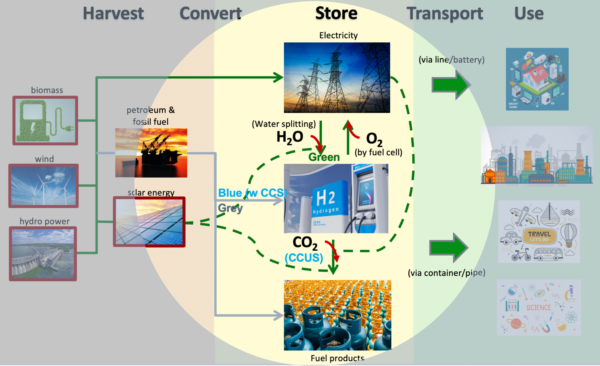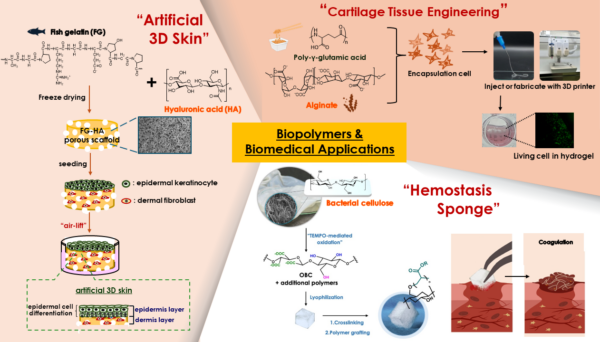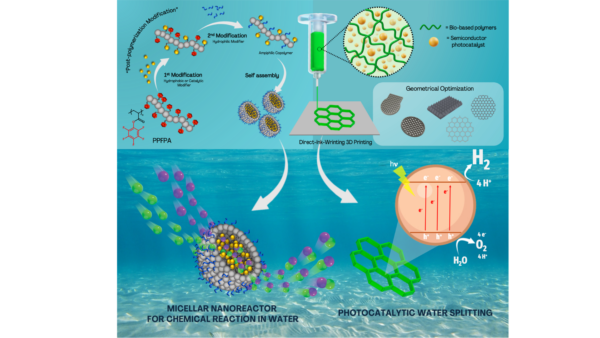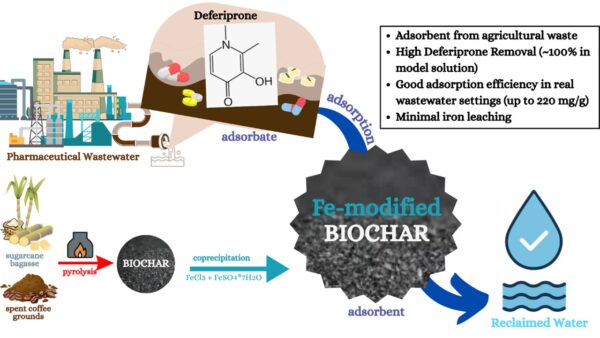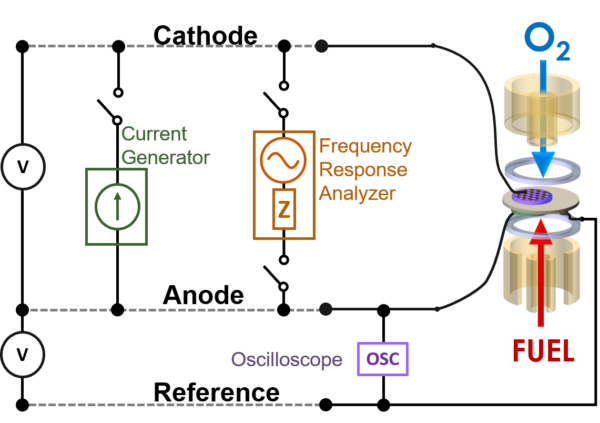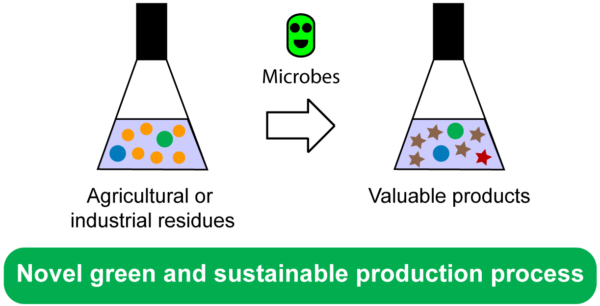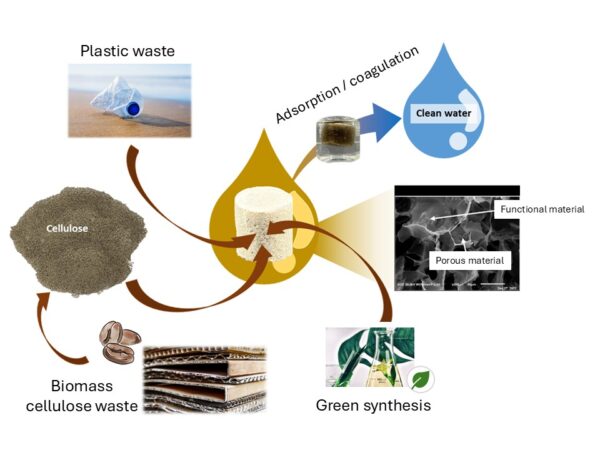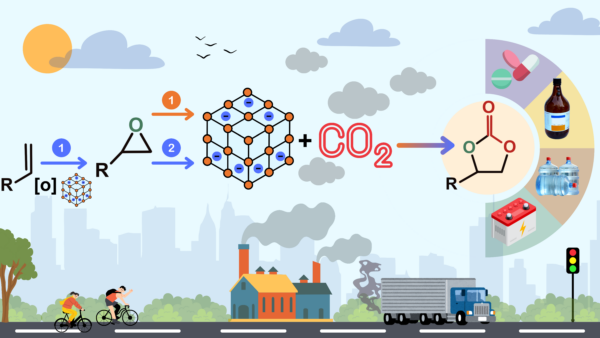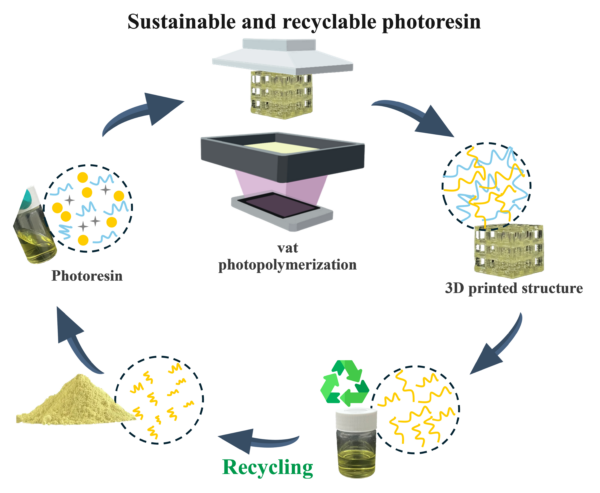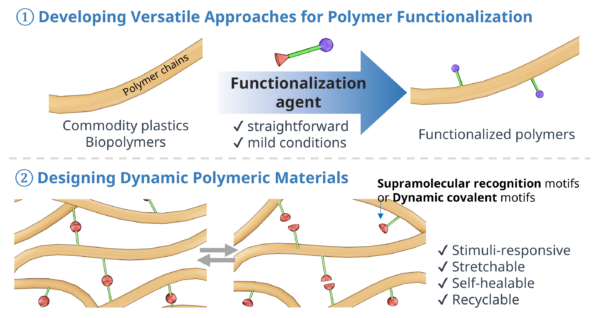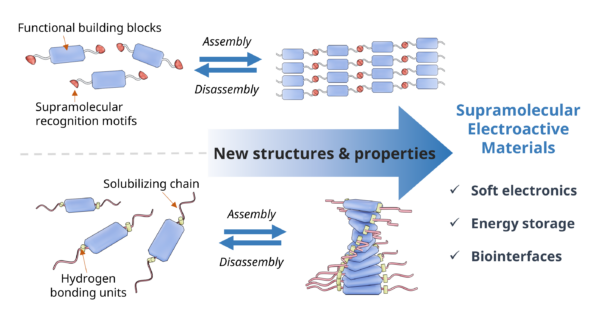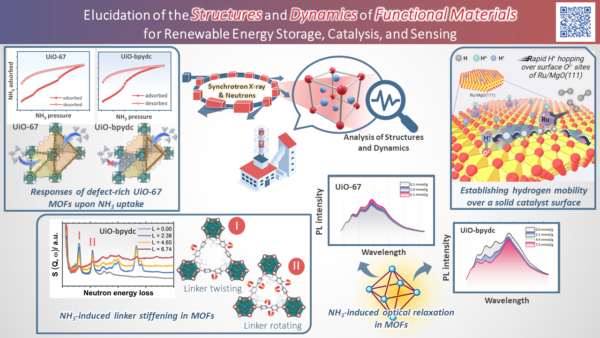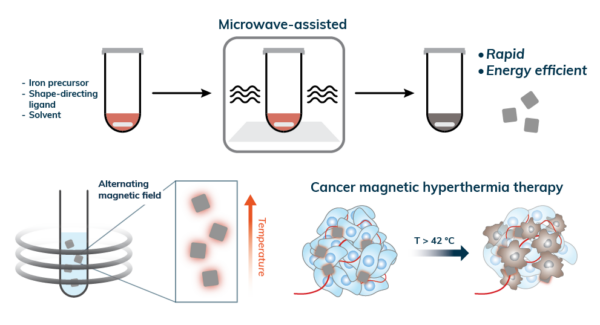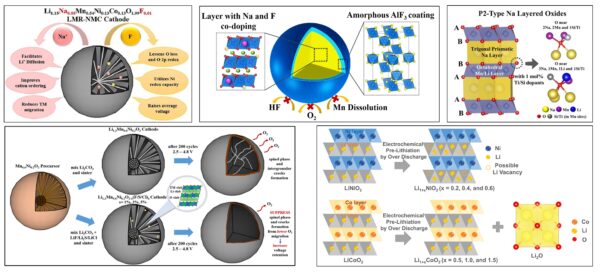Research Themes
Green and Sustainable Chemistry, BCG Economy
Prof. Patchanita Thamyongkit
(Photo)electrocatalytic green energy production and storage for net zero carbon emissions
This interdisciplinary research aims to develop frontier low carbon technology with a goal towards net zero carbon emission goal. It focuses on design and synthesis of highly conjugated oligopyrrole derivatives, especially porphyrins and phthalocyanines, and photo/redox active materials to create efficient light-harvesting and conducting systems for electrochemical and photoelectrochemical catalytic processes, especially reduction of carbon dioxide and green hydrogen production. Moreover, great effort has been put to extensive development of organic-based solar-driven flow electrocatalytic systems for practical scalable clean energy conversion and storage.
Prof. Voravee P. Hoven
Bio-derived Polymers for Biomedical Applications
Biopolymers, derived from natural sources, offer remarkable biocompatibility and biodegradability, making them ideal candidates for medical applications. This research focuses on modifying biopolymers to enhance their mechanical properties, stability, and functionality to meet the specific requirements for medical applications. In particular, we are interested in designing supportive materials to support cell growth for artificial 3D skin and cartilage tissue engineering, and hemostasis.
Prof. Voravee P. Hoven
Polymer-mediated Catalysis for Green Chemical Transformation
Green chemical transformation aims to redesign chemical processes to minimize environmental impact by reducing the use of hazardous substance or using an eco-friendly bio-based resources. Herein, we challenge a polymer-mediated catalysis for organic chemical reaction and energy conversion in water. A micellar system prepared from amphiphilic copolymers synthesized via post-polymerization modification of poly(pentafluorophenyl acrylamide) (PPFPA) with hydrophobic pockets being able to dissolve and stabilize organic substrates in water so that it can serve as nanocatalyst or nanoreactors for organic synthesis. On the other side, the fabrication of a bio-based polymer support for photocatalyst which geometrically optimized via 3D printing is explored. This hybrid material is applied for photon-driven green conversion of water to hydrogen as alternative to sustainable energy.
Assoc. Prof. Apichat Imyim
Valorization of Agricultural Residues and Wastes for Sustainable Wastewater Treatment and the Bio-Circular Economy Applications
The research focuses on transforming agricultural residues and industrial waste into high-value materials for sustainable wastewater treatment and resource recovery. Emphasizing green chemistry and circular economy principles, the work develops eco-friendly biochar adsorbents, including those derived from sugarcane bagasse and spent coffee grounds, for removing emerging contaminants, purifying industrial effluents, and capturing carbon dioxide. The study highlights a sustainable approach that links waste valorization, pollution control, and materials innovation to promote cleaner and greener chemical processes.
Assoc. Prof. Soamwadee Chaianansutcharit
Solid Oxide Fuel Cells
My research group has working on synthesis and modification of perovskites and related structures to be applied for electrodes in solid oxide fuel cell (SOFC). The doping of metals on A- and B- site in the perovskite structure can alter thermal and electrochemical properties of materials. To understand the material behavior, phase structure, morphology, thermal expansion behavior, oxygen permeation flux, and impedance of materials are investigated. The potential materials will then be fabricated as electrodes for a single planar electrolyte-supported cell and tested for catalytic reaction under H2 fuel at intermediate temperature (500-800oC).
Assoc. Prof. Nawaporn Vinayavekhin
Microbial or enzymatic biotransformation of agricultural and industrial residues into value-added products
Agricultural and industrial residues pose a significant environmental challenge but also offer valuable resources for sustainable biotechnological applications. This research aims to harness the potential of microorganisms and enzymes to convert these residues, such as ginger bagasse, aloe vera peel, and polyphenols from sugarcane bagasse, into valuable products. The ability of isolated microbes to biotransform or couple these materials with other chemicals will be investigated using TLC, HPLC, and LC-MS-based untargeted metabolomics analyses. The biotransformed products will be structurally characterized using NMR, MS, and other appropriate chromatographic techniques, and tested for biosurfactant properties, antimicrobial activities, and plant growth-promoting effects. Finally, the biotransformation mechanisms will be elucidated by isolating and characterizing the involved enzymes. We hope this study will provide new insights and practical applications for the biotransformation of agricultural and industrial residues, contributing to environmental sustainability and innovative biotechnological advancements.
Assoc. Prof. Fuangfa Unob
Fabrication of functional materials from biomass and plastic waste for water treatment applications
The research focuses on the reuse of biomass, plastic wastes, and cellulose-containing waste for fabricating functional materials for water treatment. Cellulose and functional compounds (e.g. polyphenol compounds) are extracted from biomass and cellulose-rich waste (e.g. carboard boxes, office papers waste) and used to fabricate adsorbents. Bio-coagulants are also prepared from these starting materials for use in coagulation processes as a substitute for chemical coagulants. Additionally, plastic waste is utilized for either physical or chemical recycling to produce porous materials. In most of these processes, sustainable methodologies are adopted, including the use of safer solvents and processes designed to minimize energy consumption.
Assoc. Prof. Wipark Anutrasakda
Development of heterogeneous catalysts for the conversion of carbon dioxide to value-added products
The rapid rise in carbon dioxide (CO2), a major greenhouse gas, poses a significant threat to both human and environmental well-being. Therefore, the process for converting CO2 into value-added chemicals offers a promising solution, as it simultaneously reduces atmospheric CO2 levels and achieves utilization. Among the valuable chemicals that can be produced from CO2 conversion are cyclic carbonates. These versatile molecules have numerous applications, including serving as precursors for polycarbonate synthesis, solvents, battery electrolytes, and even additives in pharmaceuticals and petroleum. Our research group is particularly interested in developing MOF- and silica-based catalysts for converting CO2 into cyclic carbonates. We focus on two main approaches: i) one-step reaction, where this method utilizes monofunctional catalysts to directly convert epoxides and CO2 into cyclic carbonates and ii) one-pot two-step reaction, where bifunctional catalysts facilitate a two-step process, starting with alkenes and CO2, to ultimately yield cyclic carbonates. To achieve highly efficient catalysts, we functionalize the surface of MOF or silica to increase the number of catalytic sites. Furthermore, we also enlarge pores of the to facilitate the diffusion of reactants into and products out of the pores of the catalysts.
Assist. Prof. Panuwat Padungros
Salt-Free CatAnionic Vesicular Nanoreactor from Dithiocarbamate: Michael Addition of Nitroolefins in Aqueous Vesicle System
The salt-free CatAnionic vesicle was previously generated by mixing cationic and anionic amphiphiles, and removing the salt that occurred as a side product from the mixture. A new strategy to produce the salt-free CatAnionic vesicle of N,N-dialkylamonium N,N dialkyldithiocarbamate (AmDTC) through a one-step condensation between secondary amine and carbon disulfide is demonstrated. Both cationic (dialkylamonium) and anionic (dithiocarbamate) amphiphiles were generated concurrently during the condensation. The AmDTC dispersed in water, resulting in the spontaneous formation of salt-free CatAnionic vesicles. Among several AmDTCs, the N,N-didodecylamonium N,N-didodecyldithiocarbamate (AmDTC-C12C12) showed high stability and applied as a vesicular nanoreactor for the Michael addition in water. Michael addition between nitroolefins and 1,3-dicarbonyl compounds yielded the desired twenty-three Michael adducts, with yields ranging from 65% to 92%. It is hypothesized that the AmDTC-C12C12 serves as a vesicular nanoreactor and plays a role in catalysis at the dithiocarbamate group. Preparative-scale and one-pot Michael addition by in situ generation of AmDTC-C12C12 vesicle afforded the Michael adducts also in good yields. The AmDTC-C12C12 vesicular nanoreactor was applied for the synthesis of (±)-baclofen with 54% yields over three steps. Reusability of the AmDTC-C12C12 was demonstrated and allowed the reuse up to seven cycles. The chemical recycling was demonstrated by converting AmDTC-C12C12 to N,N-didodecylammonium chloride by simple acidification.
Assist. Prof. Benjaporn Narupai
Sustainable and Recyclable Photoresin for 3D printing
Additive manufacturing, also known as 3D printing, is a highly versatile platform that enables the on-demand fabrication of objects with precise control over composition and architecture. The development of materials specifically designed for 3D printing is crucial for a wide range of applications, including personal healthcare, biomedical devices, soft robotics, and tissue engineering. Our team is focused on developing a sustainable and recyclable photosensitive resin for 3D printing via vat photopolymerization. This resin is recyclable through depolymerization and inherent degradability, allowing for material recovery and reprocessing without significant loss in quality. These characteristics position our photosensitive resins as a promising, eco-friendly solution for advancing sustainable practices in additive manufacturing.
Dr. Pongphak Chidchob
Transforming common polymers with versatile functionalization strategies to create adaptable, dynamic materials
Dynamic bonds, like flexible connectors, offer the potential for polymeric materials to self-heal, respond to specific stimuli, such as changes in temperature and mechanical force, and even be recycled. However, complex synthesis, multistep processing, and the use of environmentally unfriendly chemicals in common functionalization chemistries hinder the development of dynamic polymers. Our research aims to address these issues by developing a versatile functionalization strategy that can be implemented with minimal steps under greener conditions on a broad range of commercial polymers such as commodity plastics and biopolymers. We will also investigate how different dynamic bond types influence the mechanical properties of these polymers, demonstrating the potential to combine the strength of covalent bonds with the flexibility of dynamic linkages. We anticipate that this exploration will lead to the discovery of new properties, opening the door for innovative and sustainable solutions across various fields.
Dr. Pongphak Chidchob
Designing electroactive supramolecular polymers with tunable properties for emerging technologies
Like LEGO bricks, which can be reversibly connected and disconnected, supramolecular polymers are an emerging class of materials created when molecules self-assemble through non-covalent interactions. This unique self-assembly process offers the potential to create dynamic, hierarchical structures with attractive properties such as high processability, self-healing capabilities, and responsiveness to stimuli. Our research focuses on creating electroactive supramolecular polymers using π-conjugated oligomers, acting as conductive molecular components. Through precise control over the supramolecular interactions, we aim to design materials that exhibit mixed ionic/electronic conductivity and structural adaptivity to surrounding changes in temperature fluctuations and mechanical stress. We aim to develop innovative materials for potential applications in electronics, energy, and biointerfaces.
Dr. Tatchamapan Yoskamtorn
Insights into the Structures and Dynamics of Functional Materials for Renewable Energy, Catalysis, and Sensing
In order to design next-generation nanomaterials for renewable energy storage and catalysis, our research focuses on thorough investigations of the structures and dynamics of functional materials such as metal-organic frameworks (MOFs), zeolites, and supported metal nanoparticles, with unprecedented guest-induced properties. We have a particular focus on using a multi-disciplinary approach to gain new insights into the structure of materials and their dynamic behaviours in the solid state. The utilisation of in-situ diffraction and spectroscopy, combined with theoretical calculations, is our core methodology for achieving such detailed analyses not only under realistic conditions but also at a molecular level. For instance, the combined use of synchrotron X-ray diffraction (SXRD), neutron powder diffraction (NPD), and quasielastic neutron scattering (QENS), can yield important insights into the structures and dynamics of materials and surface species, while inelastic neutron scattering (INS), Infrared and Raman spectroscopy can give information on host-guest interactions and reaction chemistry. A comprehensive analysis of guest-induced structural changes, surface adsorbates, and reaction mechanisms involved has been reported in high-quality journals. Our growing understanding will lead to better design of novel functional materials, which hold significant relevance for both fundamental science and innovative technology. In the future, we aim to expand our in-situ and integrated methods to design and develop effective catalytic systems that can be used for the chemical recycling of waste plastic.
Dr. Wid Mekseriwattana
Microwave-assisted synthesis of water-soluble iron oxide nanocubes for cancer magnetic hyperthermia therapy
Iron oxide nanocubes (IONCs) are among the most efficient magneto-responsive heating nanomaterials for magnetic hyperthermia therapy (MHT). Conventional synthesis for controlling of size and shape is based on non-hydrolytic route, which are not environmentally friendly and not suitable for biomedical applications. In this work, a new method for synthesizing IONCs with hydrophilic surfaces will be developed, based on polyol synthesis. The used of shape-directing ligands will be varied to control the size and cubic morphology of the IONCs. Microwave synthesis system will be used as a green and energetically efficient heating technique to maximize the reaction efficiency in terms of reaction time and conversion yield. The resulting IONCs will be tested based on their magneto-responsive heating properties, and their toxicity will be tested in a 2D in vitro cell culture model.
Dr. Panawan Vanaphuti
Batteries
Our research focuses on developing and optimizing energy storage materials, particularly for lithium-ion (Li-ion) and sodium-ion (Na-ion) batteries. Currently, we primarily concentrate on high-energy layered cathode materials, including lithium manganese-rich oxides, high-nickel cathodes, lithium manganese iron phosphates, and manganese-based layered oxides. To enhance electrochemical performance, structural stability, and sustainability, we employ methods such as synthesis optimization, co-doping, and surface coatings. Additionally, our work addresses challenges like material degradation, energy density limitations, and the scarcity of critical minerals, aiming to contribute to the development of cost-effective and eco-friendly battery technologies.


